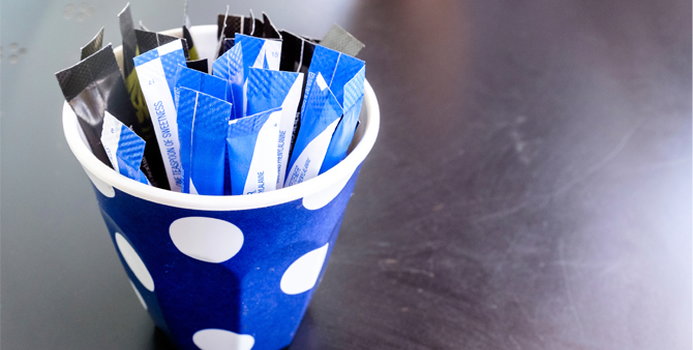High-intensity sweeteners, also commonly referred to as artificial sweeteners, are substitutes or alternatives to sugar. They are many times sweeter than table sugar, so smaller amounts of these sugar alternatives are needed to reach the same sweetness level. They are used in a variety of foods to enhance and sweeten the flavor. These high-intensity sweeteners are popular with people for a variety of reasons, primarily because they contribute either minimal or no calories to the diet and do not affect blood glucose levels.
Frequent public concern is expressed over many "artificial" food additives, including sugar substitutes. The FDA regulates food additives like high-intensity sweeteners by first submitting them to a pre-market review, unless it has been has been determined to be Generally Recognized As Safe (GRAS). To be eligible for GRAS labeling, experts qualified by scientific training and experience use scientific procedures to conclude the safeness of the product based on available information. However, it is important to note that companies can make independent GRAS determinations of foods without notifying the FDA. After reviewing the available scientific evidence, the FDA determines that "high-intensity sweeteners approved by FDA are safe for the general population under certain conditions of use."
Standards of safety defined in the FDA's regulations require products to meet the standard of reasonable certainty of no harm under intended conditions of its use. This is the same for food additives or foods determined GRAS. The FDA established Acceptable Daily Intake (ADI) levels for the approved high-intensity sweeteners. ADI is the amount of the high-intensity sweetener that is considered safe to consume each day over the course of a person's lifetime. The FDA determined that the estimated daily intake, even for people who really enjoy sugar alternatives, would not exceed the ADI. The idea is that there are no safety concerns if the average daily intake less than the ADI. Once again, moderation and appropriate intake is key.
There are currently six high-intensity sweeteners permitted for use in food in the United States.
Acceptable Daily Intake (ADI) is in milligrams per kilogram body weight per day (mg/kg bw/d)
- Brand names Sunett® and Sweet One®
- ~200x sweeter than table sugar and is often combined with other sweeteners
- ADI: is 15 (mg/kg bw/d), or about 165 packets
- Advantame
- ~20,000x sweeter than table sugar (sucrose)
- ADI: is 32.8 (mg/kg bw/d), or about 4,000 packets per day
- Brand names include Nutrasweet®, Equal®, and Sugar Twin®
- ~ 200x sweeter than table sugar
- Does contain calories but due to sweetness consumers are likely to use much less of it. It is the only approved nutritive sugar-substitute because it contains more than 2% of the calories in the equivalent amount of sugar.
- People who have a genetic disorder called Phenylketonuria (PKU) should avoid or restrict aspartame because they have problems metabolizing phenylalanine. Labels must include a statement to inform if a product contains phenylketonurics/phenylalanine.
- ADI: is 50 (mg/kg bw/d), or about 165 packets per day
- Brand name Newtame®
- ~ 7,000 to 13,000x sweeter than table sugar
- ADI: is .3 (mg/kg bw/d), or about 200 packets per day
- Brand names include Sweet and Low®, Sweet Twin®, Sweet'N Low®, and Necta Sweet®
- ~200-700x sweeter than table sugar
- ADI: is 15 (mg/kg bw/d), or about 250 packets per day
- Brand name Splenda®
- ~600x sweeter than table sugar
- ADI: is 5 (mg/kg bw/d), or about 165 packets per day
- Another popular high-intensity sweetener is made from the Stevia plant. The Steviol Glycosides obtained from the leaves of this plant are very sweet and have been submitted to the FDA to become a GRAS.
Stevia/high purity steviol glycosides
- Brand names include Truvia®, PureVia®, Enliten®
- ~200-400x sweeter than table sugar
- Although not yet determined by the FDA, the Joint FAO/WHO Expert Committee on Food Additives (JECFA) ADI is 4(mg/kg bw/d), or about 29 packets
High-intensity sweeteners are most commonly found foods and beverages that are labeled "diet," "sugar-free," "diabetic-friendly," "no added sugar" or "low in calories". These non-nutritive sweeteners are used in soft drinks, candy, jellies, dairy products, baked goods, desserts and many other foods. You can identify high-intensity sweeteners in ingredient lists on packaging.
Emily DeLacey MS, RD is a Registered Dietitian and currently working in Jamaica as a HIV/ AIDS Prevention Specialist. She attended Central Washington University for her Bachelor's Degree in Science and Dietetics and continued on after her internship to Kent State University for her Master's Degree in Science and Nutrition, with a focus on public health and advocacy. She served as a U.S. Peace Corps Volunteer in Malawi 2012-2014 working as a Community Health Advisor in a rural village, immersing in the joys of life without electricity or running water. She has been to 20+ countries and 47 of the 50 states in the US. Traveling, adventuring and experiencing new cultures has made her a passionate advocate for the equality of nutrition and wellness for all people.




